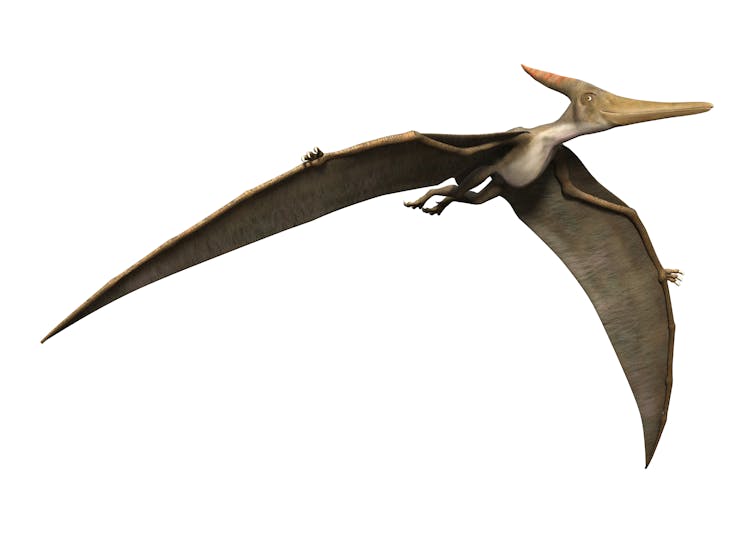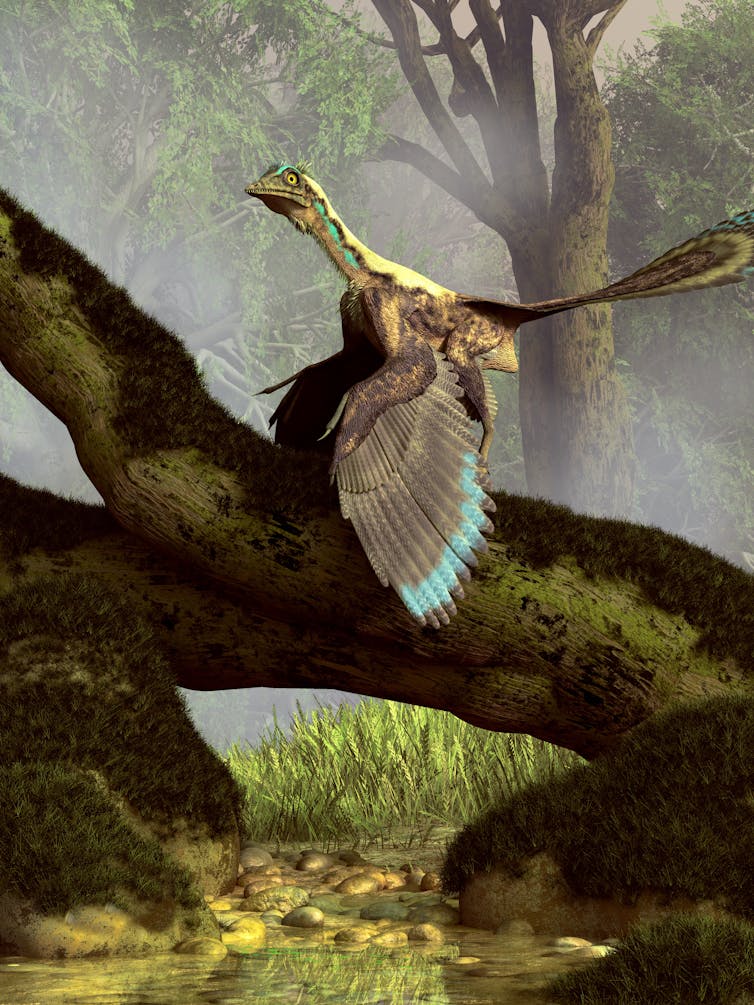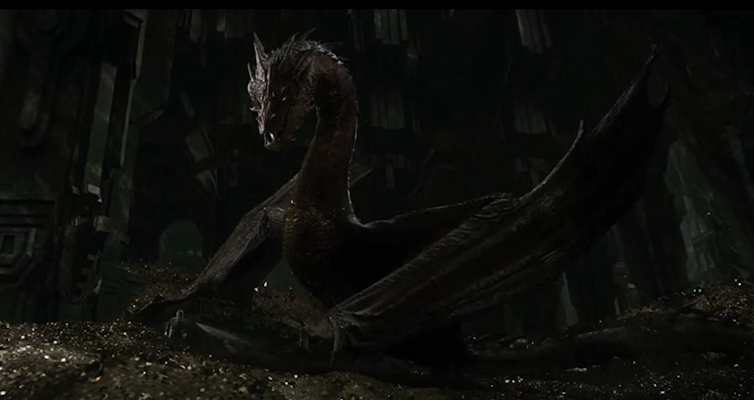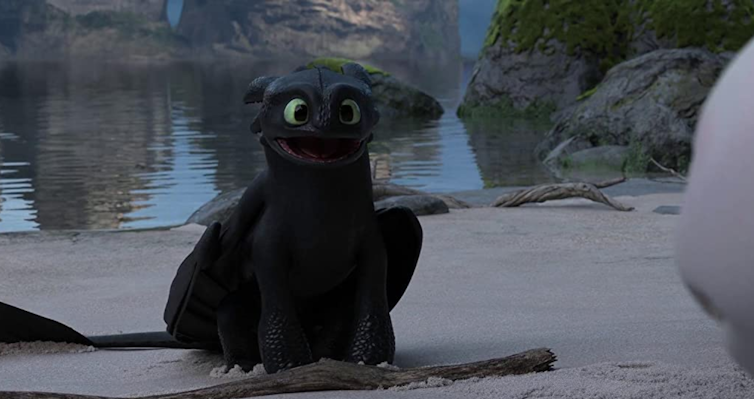Curious Kids: why can't humans grow wings?
- Written by John Long, Strategic Professor in Palaeontology, Flinders University
Why can’t humans grow wings? Christina, age 9, Beijing, China.
Hi Christina! Great question.
Humans are animals that have backbones. This means we’re in a group called “vertebrates” – along with fish, amphibians (such as frogs), reptiles, birds and mammals.
A long time ago, humans weren’t around. We actually came from 500-million-year-old fish that had no arms, legs or jaws. But slowly, from one fish parent to the next, they changed. Some started to grow arms and legs, eventually leading to humans as they are today.
These very slow changes happen to all animals over millions of years, in a process we call evolution. Every part of the human body, and every other animal, evolved in this way.
Read more: Curious Kids: how do scientists know evolution is real?
Two arms, two legs: a basic vertebrate body plan
Fish were the first vertebrates to have pairs of limbs. For humans, these are our arms and legs. Fish have pairs of fins at their front and back.
A long time ago, some fish evolved bones in their fins that would later become human fingers. This pattern of having pairs of two limbs (four in total) resulted in the bodies vertebrates have today.
All vertebrates today have the same body plan: two arms, two legs, a head with two eyes, two nostrils, a mouth with teeth, and so on.
However over the course of evolution, some animals didn’t quite follow this plan exactly. Their bodies needed to be different to suit their lifestyle – whether this was swimming or flying. This is how wings came about.
How animals started to fly
Wings of flying vertebrates, such as birds, are simply modified arms that help them fly.
You may have heard of pterosaurs – the (sometimes huge) flying creatures that lived at the time as dinosaurs. Pterosaurs also slowly formed their wings over many, many years. They did this by growing one long finger connecting a thin layer of skin called a membrane to the rest of their body.
 Pterosaurs weren’t dinosaurs – rather, they were flying reptiles.
Shutterstock
Pterosaurs weren’t dinosaurs – rather, they were flying reptiles.
Shutterstock
One group of dinosaurs evolved into birds about 160 million years ago.
This happened well after dinosaurs first gained feathers to help keep their bodies cool or warm as needed. Then, from one parent to the next, they slowly gained longer front arms to eventually make wings.
 One extinct dinosaur called archaeopteryx looked a bit like a dinosaur, and a bit like bird too. It is often pointed to as an evolutionary link between today’s birds and extinct feathered dinosaurs.
Shutterstock
One extinct dinosaur called archaeopteryx looked a bit like a dinosaur, and a bit like bird too. It is often pointed to as an evolutionary link between today’s birds and extinct feathered dinosaurs.
Shutterstock
Why didn’t humans evolve to have wings?
Now let’s look at why humans can’t grow wings.
All living things, including vertebrates, have genes. These are like little instruction booklets inside our bodies that decide how we grow and what our bodies can do. We can’t change what our genes do. For example, your genes are the reason your eyes may be black, or brown, or blue – but you can’t control this.
We also have genes called “hox genes”. These make sure our bodies grow a certain way as we get older. For instance, while you might grow taller thank your siblings, hox genes make sure you only grow two arms and two legs – and not eight legs like a spider. In fact, a spider’s own hox genes are what give it eight legs.
So one main reason humans can’t grow wings is because our genes only let us grow arms and legs.
What if we did have wings though?
Even if humans did have wings, we wouldn’t immediately be able to fly.
To fly, we would also need the right body size and metabolism. Metabolism is our body’s ability to use fuel (such as from the food we eat) to make energy, which helps us move.
Birds have very higher metabolisms than us. A hummingbird’s heart can beat up to 1,200 times per minute, while a human athlete’s heart might only go as fast as 220 beats per minute. This means hummingbirds can burn energy better than humans.
Flying birds also have much lighter bones that help them breathe better, feathers that help lift them while flying, and powerful lungs that keep oxygen pumping through their bodies.
Unless humans had all of this, we wouldn’t be able to fly even if we did have wings. Dinosaurs also only evolved to become birds by making their bodies much smaller and lighter over time.
Read more: Curious Kids: are humans going to evolve again?
What about dragons?
While we know dragons aren’t real, some imaginary dragons have bodies close to real-life vertebrates.
Dragons such as Smaug in the movie The Hobbit have wings and legs only. So if Smaug was real he might actually have been able to fly, as long as he was light, had a high metabolism and a membrane to form his wings.
 If Smaug the dragon was real, he may have been able to fly! (Lucky he’s not).
Warner Bros
If Smaug the dragon was real, he may have been able to fly! (Lucky he’s not).
Warner Bros
On the other hand, the dragon Night Fury from How to Train Your Dragon has arms, legs and wings. In real life, this would be like having two legs and two pairs of arms.
Night Fury breaks the basic rules of evolution as no vertebrate has ever evolved to have this combination of arms and legs. Insects can, but they don’t have backbones so they’re not vertebrates.
So if Night Fury was real, scientists may have to call him an insect.
 Night Fury from How to Train Your Dragon is a very likeable, but not a very realistic character.
DreamWorks Animation/IMDB
Night Fury from How to Train Your Dragon is a very likeable, but not a very realistic character.
DreamWorks Animation/IMDB
Authors: John Long, Strategic Professor in Palaeontology, Flinders University
Read more https://theconversation.com/curious-kids-why-cant-humans-grow-wings-142654






